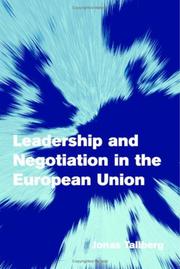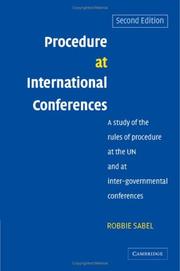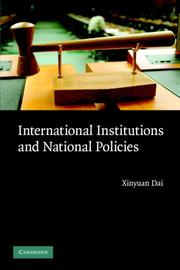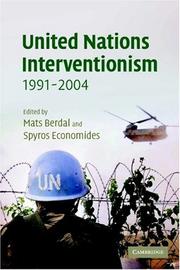| Listing 1 - 6 of 6 |
Sort by
|

ISBN: 0521864526 0521683033 9780521864527 9780521683036 9780511492075 0511246382 9780511246388 9780511247071 0511247079 0511244908 9780511244902 051124567X 9780511245671 0511492073 9786610702756 6610702756 1107169496 1280702753 051131860X Year: 2006 Publisher: Cambridge ; New York : Cambridge University Press,
Abstract | Keywords | Export | Availability | Bookmark
 Loading...
Loading...Choose an application
- Reference Manager
- EndNote
- RefWorks (Direct export to RefWorks)
In this 2006 book, Jonas Tallberg offers a novel perspective on some of the most fundamental questions about international cooperation and European Union politics. Offering the first systematic theoretical and empirical exploration of the influence wielded by chairmen of multilateral negotiations, Tallberg develops a rationalist theory of formal leadership and demonstrates its explanatory power through carefully selected case studies of EU negotiations. He shows that the rotating Presidency of the EU constitutes a power platform that grants governments unique opportunities to shape the outcomes of negotiations. His provocative analysis establishes that Presidencies, while performing vital functions for the EU, simultaneously exploit their privileged political position to favour national interests. Extending the scope of the analysis to international negotiations on trade, security and the environment, Tallberg further demonstrates that the influence of the EU Presidency is not an isolated occurrence but the expression of a general phenomenon in world politics - the power of the chair.
International relations. Foreign policy --- European Union --- Political leadership --- Diplomatic negotiations in international disputes. --- Leadership politique --- Négociations diplomatiques dans les conflits internationaux --- #SBIB:327.7H220 --- 260 Europese Unie --- Voorzitterschap Europese Unie --- Europese Unie: instellingen en besluitvorming --- Négociations diplomatiques dans les conflits internationaux --- Diplomatic negotiations in international disputes --- Leadership --- Negotiations in international disputes --- Pacific settlement of international disputes --- Social Sciences --- Political Science

ISBN: 9780521837125 0521545552 9780521545556 052183712X 9780511494444 0511494440 0511161743 9780511161742 1107150280 1280458445 0511191286 0511160445 0511313160 0511161018 Year: 2006 Publisher: New York : Cambridge University Press,
Abstract | Keywords | Export | Availability | Bookmark
 Loading...
Loading...Choose an application
- Reference Manager
- EndNote
- RefWorks (Direct export to RefWorks)
This new edition is a comprehensive manual of the rules of procedure for the conduct of business at the UN General Assembly, at international conferences and at assemblies of inter-governmental organisations such as the IAEA, ICAO, ILO, IMO and WHO. It examines the legal basis of these rules, the history of their development and the attempts at their codification. At the heart of the book is an examination of the practical applications of rules of procedure. Sabel also considers whether certain procedural rules and applications have become so well established that they have now attained the status of customary international law. The book is of interest to those involved in international law, international relations and international organisations. It also serves as a practical manual for delegates to the UN General Assembly and to international conferences.
Conference proceedings. --- Congresses and conventions. --- International agencies --- Colloquia --- Colloquiums --- Conferences --- Conventions (Congresses) --- International conferences, congresses and conventions --- Symposia --- Symposiums --- Intellectual cooperation --- Convention facilities --- Convention proceedings --- Meeting proceedings --- Proceedings of conferences --- Congresses and conventions --- Droit international --- Législation --- Organisations internationales --- Law --- General and Others --- Assemblée parlementaire --- Congrès et conférences --- Négociations diplomatiques dans les conflits internationaux

ISBN: 9780521696319 0521696313 9780521874045 0521874041 9780511491320 1107181429 1281146277 9786611146276 0511367066 1139132814 0511366434 0511491328 0511365802 0511367651 9780511367656 9780511366437 9780511365805 9781107181427 9780511367069 661114627X 9781281146274 9781139132817 9780511365805 Year: 2007 Publisher: Cambridge : Cambridge University Press,
Abstract | Keywords | Export | Availability | Bookmark
 Loading...
Loading...Choose an application
- Reference Manager
- EndNote
- RefWorks (Direct export to RefWorks)
The proliferation of international institutions and their impact has become a central issue in international relations. Why do countries comply with international agreements and how do international institutions influence national policies? Most theories focus on the extent to which international institutions can wield 'carrots and sticks' directly in their relations with states. Xinyuan Dai presents an alternative framework in which they influence national policies indirectly by utilizing non-state actors (NGOs, social movements) and empowering domestic constituencies. In this way, even weak international institutions that lack 'carrots and sticks' may have powerful effects on states. Supported by empirical studies of environmental politics, human rights and economic and security issues, this book sheds fresh light on how and why international institutions matter. It will be of interest to students, scholars and policymakers in both international relations and international law.
International relations. Foreign policy --- International agencies --- 341.2 --- Associations, International --- IGOs (Intergovernmental organizations) --- Institutions, International --- Intergovernmental organizations --- International administration --- International associations --- International governmental organizations --- International institutions --- International organizations --- International unions --- Organizations, International --- Specialized agencies of the United Nations --- International cooperation --- Interorganizational relations --- Non-state actors (International relations) --- International organization --- Inter-governmental organizations --- Droit international --- Organisations internationales --- Social Sciences --- Political Science --- International agencies. --- Négociations diplomatiques dans les conflits internationaux --- Relations internationales --- International cooperation.
Book
ISBN: 9782728310937 2728310939 2728310947 Year: 2015 Volume: 504 Publisher: Roma: École française de Rome,
Abstract | Keywords | Export | Availability | Bookmark
 Loading...
Loading...Choose an application
- Reference Manager
- EndNote
- RefWorks (Direct export to RefWorks)
Consacré aux écrits relatifs à l’ambassadeur et à l’art de négocier, ce livre suit au fil d’une vingtaine d’études le long et multiforme travail d’élaboration auquel la figure de l’ambassadeur et l’art de la négociation ont donné lieu, de la genèse de nouvelles formes d’organisation politique à la fin du Moyen Âge jusqu’à l’émergence de la profession diplomatique à la fin du XVIIIe siècle et au XIXe siècle. Certains des textes examinés, comme les traités de legatis ou le Guide de Martens, présentent une dimension théorique ou pédagogique. D’autres sont des écrits littéraires, des instruments juridiques ou des actes de la pratique où se lit, de façon plus ou moins incidente, une réflexion sur les envoyés diplomatiques et l’art qu’ils mettaient en œuvre. Qu’ils aient été composés pour accréditer une fonction, défendre des privilèges, forger des modèles de comportement ou transmettre à de futurs praticiens les leçons de l’expérience, ces textes montrent comment, des docteurs médiévaux aux professeurs du XIXe siècle, en passant par les humanistes et les négociateurs du Grand Siècle, la figure de l’ambassadeur et les règles de son art ont été sans cesse construites et reconstruites. Aussi, à travers l’étude de ce vaste corpus, ce livre invite à un parcours dans les savoirs de la diplomatie, de l’ambaxiator médiéval aux lendemains du Congrès de Vienne.
Ambassadors. --- Diplomatic history. --- Diplomatic negotiations in international disputes. --- Diplomatic negotiations in international disputes --- Diplomacy --- International relations --- Ambassadors --- Négociations diplomatiques dans les conflits internationaux --- Diplomatie --- Relations internationales --- Ambassadeurs --- History --- Congresses --- History. --- Congresses. --- Histoire --- Congrès --- Europe. --- Négociations diplomatiques --- Europe --- Diplomatic history --- Négociations diplomatiques dans les conflits internationaux --- Congrès --- Histoire. --- General history of Europe --- Commissioners, High (Ambassadors) --- High commissioners (Ambassadors) --- Ministers (Diplomatic agents) --- Diplomats --- Negotiations in international disputes --- Pacific settlement of international disputes --- Council of Europe countries --- Eastern Hemisphere --- Eurasia --- Diplomatic negotiations in international disputes - History - Congresses --- Ambassadors - History - Congresses --- Europe - Diplomatic history - Congresses --- histoire --- politique --- négociations diplomatiques --- ambassadeur --- langage diplomatique
Periodical
ISSN: 1382340X 15718069 Year: 1996 Publisher: The Hague Kluwer Law International
Abstract | Keywords | Export | Availability | Bookmark
 Loading...
Loading...Choose an application
- Reference Manager
- EndNote
- RefWorks (Direct export to RefWorks)
International relations. Foreign policy --- Negotiation --- Diplomatic negotiations in international disputes --- Crisis management --- Négociations --- Négociations diplomatiques dans les conflits internationaux --- Gestion de crise --- Periodicals --- Périodiques --- Mediation, International --- International relations --- Médiation internationale --- Relations internationales --- Publications périodiques. --- Relations internationales. --- Négociations internationales. --- Droit international. --- Règlement de différends. --- Diplomatic negotiations in international disputes. --- International relations. --- Mediation, International. --- Business, Economy and Management --- Law --- Social Sciences --- International Business & Transnational Corporations --- Arbitration, Education & Training --- Foreign Trade & Commercial Transactions --- Foreign Policy, Defense and Internal Security --- General and Others --- Regional and International Studies --- Conciliation, International --- International conciliation --- International mediation --- Coexistence --- Foreign affairs --- Foreign policy --- Foreign relations --- Global governance --- Interdependence of nations --- International affairs --- Peaceful coexistence --- World order --- Negotiations in international disputes --- Law and legislation --- Diplomacy & International Relations. --- Negotiation. --- Mediation --- Arbitration (International law) --- Pacific settlement of international disputes --- National security --- Sovereignty --- World politics --- Internationale politiek. Buitenlandse politiek

ISBN: 9780521547673 0521547679 9780521838979 0521838975 9780511491221 1107162327 0511274408 0511275102 0511320884 0511491220 1280815345 0511272782 0511273576 9780511275104 9780511273575 9780511274404 9781107162327 9781280815348 9780511272783 9780511320880 Year: 2007 Publisher: Cambridge, UK ; New York : Cambridge University Press,
Abstract | Keywords | Export | Availability | Bookmark
 Loading...
Loading...Choose an application
- Reference Manager
- EndNote
- RefWorks (Direct export to RefWorks)
After years of paralysis, the 1990s saw an explosion in the number of United Nations field operations around the world. In terms of scope and level of ambition, these interventions went beyond the tried and tested principles of classical UN peacekeeping. Indeed, in some cases - such as Cambodia, Kosovo and East Timor - the UN presence assumed the form of quasi-protectorates designed to steer war-torn and deeply divided societies towards lasting peace. This book examines the UN's performance and assesses the wider impact of 'new interventionism' on international order and the study of international relations. Featuring eight case studies of major UN interventions and an introductory chapter outlining the most important theoretical and political features of the international system which have led to the increased interventionary practices of the UN, this book will appeal to students and researchers in international relations and international organizations.
Peacekeeping forces --- Diplomatic negotiations in international disputes --- Intervention (International law) --- World politics --- Maintien de la paix --- Négociations diplomatiques dans les conflits internationaux --- Intervention (Droit international) --- Politique mondiale --- Case studies. --- Cas, Etudes de --- United Nations. --- World politicsUnited Nations. --- Intervention (International law). --- Négociations diplomatiques dans les conflits internationaux --- Social Sciences --- Political Science --- Military intervention --- Diplomacy --- International law --- Neutrality --- Negotiations in international disputes --- Pacific settlement of international disputes --- Peacekeeping (Military science) --- Peacekeeping operations --- Armed Forces --- International police --- Peace-building --- UNO --- Naciones Unidas --- Nations Unies --- ONU --- Organisation des Nations Unies --- Organizat︠s︡ii︠a︡ Obʺedinennykh Nat︠s︡iĭ --- OON --- Vereinigte Nationen --- Umot ha-meʼuḥadot --- Organizacja Narodów Zjednoczonych --- ONZ --- Forente nasjoner --- Forenede nationer --- FN --- Förenta nationerna --- Gaertʻianebuli erebi --- Organização das Nações Unidas --- PBB --- Perserikatan Bangsa-Bangsa --- Kokusai Rengō --- Kokuren --- ENSZ --- Egyesült Nemzetek Szövetsége --- Birleșmiș Milletler Teșkilâtı --- Birlăşmiş Millătăr Tăşkilatı --- Birlashgan Millatlar Tashkiloti --- BMT --- YK --- Yhdistyneet kansakunnat --- OUN --- Organizacija Ujedinjenih Nacija --- UN --- NU --- Nazioni Unite --- OSN --- Organizace spojených národů --- Sāzmān-i Milal-i Muttafiq --- Bangsa² Bersatu --- Organización de las Naciones Unidas --- Ühinenud Rahvaste Organisatsioon --- ÜRO --- Organismos tōn Hēnōmenōn Ethnōn --- Umoja wa Mataifa --- Vereinten Nationen --- Vereinte Nationen --- Hayʼat al-Umam al-Muttaḥidah --- Verenigde Naties --- VN --- Organizația Națiunilor Unite --- Um --- Lien ho kuo --- OKB --- Organizata e Kombeve të Bashkuara --- Lian he guo --- U.N. --- Umam al-Muttaḥidah --- OĒE --- Hēnōmena Ethnē --- Organizácia Spojených Národov --- Sahaprachāchāt --- Națiunile Unite --- Organizat︠s︡ii︠a︡ na obedinenite nat︠s︡ii --- Organismos Hēnōmenōn Ethnōn --- Manẓūmat al-Umam al-Muttaḥidah --- AAN --- Arhanizatsyi︠a︡ Ab'i︠a︡dnanykh Natsyĭ --- Nações Unidas --- Orhanizat︠s︡ii︠a︡ Ob'i︠e︡dnanykh Nat︠s︡iĭ --- O.Ē.E. --- ʻOngkān Sahaprachāchāt --- Sjuninejal Konob'laq --- Sāzmān-i Milal-i Muttaḥid --- Milal-i Muttaḥid --- Nėgdsėn U̇ndėstniĭ Baĭguullaga --- NUB --- Rāshṭrasaṃgha --- או״מ --- أمم المتحدة --- الأمم المتحدة --- سازمان ملل متحد --- 国際連合 --- 联合囯 --- 聯合國 --- United Nations Organization --- Liên Hiệp Quó̂c --- Liên Hợp Quó̂c --- LHQ --- Kula Samagga --- YūʼAṅʻnʻ --- 联合国 --- Организация на обединените нации --- Организация Объединённых Наций
| Listing 1 - 6 of 6 |
Sort by
|

 Search
Search Feedback
Feedback About UniCat
About UniCat  Help
Help News
News